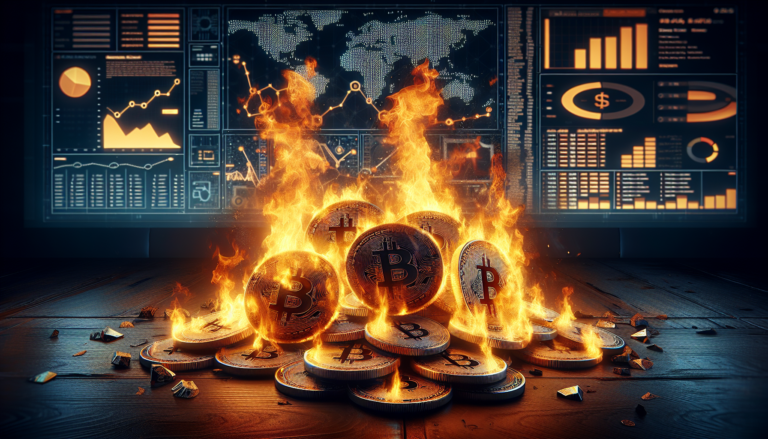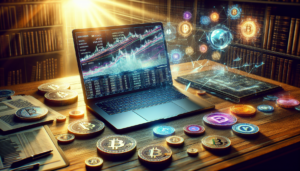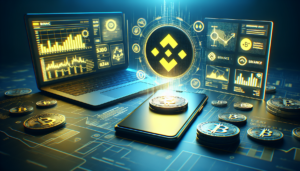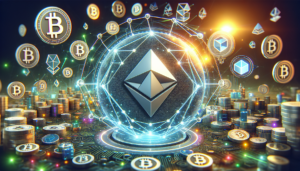Token burning is a term that has gained significant attention in the cryptocurrency world. It refers to the process of permanently removing a certain number of tokens from circulation, thus reducing the total supply. This action is often taken by project owners and developers as a means to control inflation, create scarcity, and potentially increase the value of the remaining tokens.
The concept of burning cryptocurrency has its roots in traditional finance, where companies buy back their own shares to reduce the circulating supply and boost the value of the remaining shares. In the crypto space, instead of buying back, tokens are sent to a special “burn” address, which is an irretrievable public address on the blockchain. Once tokens are sent to this address, they are effectively taken out of circulation forever.
Introduction to Token Burning
Definition and Purpose
Token burning is the process of permanently removing tokens from circulation to manage supply. The primary purpose of burning tokens is to create scarcity and potentially increase the value of the remaining tokens in circulation. By reducing the total supply, the demand for the token may rise if the project continues to generate interest and adoption.
Token burning is a common practice in deflationary token models, where the circulating supply decreases over time. This is in contrast to inflationary models, where new tokens are minted and added to the circulating supply, potentially devaluing each token if demand does not grow proportionally.
Historical Context and Evolution
The concept of token burning gained prominence with the rise of Initial Coin Offerings (ICOs) and the subsequent need for projects to manage their token supply responsibly. Many projects allocated a portion of their tokens for burning to create scarcity and demonstrate their commitment to long-term value creation.
Over time, token burning has evolved from a one-time event to a continuous process integrated into the protocol’s economics. For example, some projects burn a percentage of transaction fees to create a deflationary pressure on the token supply. This approach aims to align the interests of token holders with the long-term sustainability of the project.
Mechanics of Token Burning
How Tokens Are Burned
Token burning is typically executed through smart contracts, which are self-executing programs on the blockchain. The smart contract contains a function that allows the project owners to send a specified number of tokens to a dedicated “burn address.” This address is a valid public address on the blockchain, but it does not have a corresponding private key. As a result, tokens sent to this address are permanently lost and cannot be recovered.
Some projects automate the token burning process by integrating it into their protocol’s rules. For instance, a percentage of each transaction fee may be automatically sent to the burn address. This ensures a continuous and predictable reduction in the token supply over time.
Role of Smart Contracts
Smart contracts play a crucial role in executing token burns transparently and securely. They eliminate the need for manual intervention and ensure that the burning process follows predefined rules. The smart contract code is publicly auditable, allowing anyone to verify the burning mechanism and the total number of tokens burned.
Furthermore, smart contracts enable the automation of complex burning schedules. For example, a project may program its smart contract to burn a specific number of tokens at regular intervals or based on certain milestones. This level of automation and transparency helps build trust among token holders and the wider community.
Economic Implications of Token Burning
Impact on Supply and Demand
By reducing the total supply of tokens, burning can alter the supply and demand dynamics in the market. If demand for the token remains constant or increases while the supply decreases, the token’s value may appreciate. This is based on the fundamental economic principle of scarcity – when a resource is limited, its value tends to increase.
However, it is essential to note that token burning alone does not guarantee an increase in value. The token’s value ultimately depends on the project’s adoption, utility, and overall market sentiment. Burning tokens can be seen as a tool to align the token’s supply with its demand, but it is not a magic solution for price appreciation.
Inflation Control
Token burning is often used as a mechanism to control inflation in cryptocurrency ecosystems. Inflation occurs when the supply of a token increases faster than the demand, leading to a decrease in the token’s purchasing power. By regularly burning tokens, projects can counteract inflation and maintain a stable or deflationary token supply.
Deflationary token models, supported by token burning, aim to preserve or increase the token’s purchasing power over time. This can incentivize holding behavior among token owners, as they may expect their tokens to appreciate in value as the supply decreases.
Market Sentiment and Token Burning
Influence on Market Sentiment
Token burning events can have a significant impact on market sentiment. When a project announces a token burn, it often generates positive sentiment among token holders and potential investors. The act of burning tokens is perceived as a sign of confidence in the project’s long-term prospects and a commitment to creating value for token holders.
Positive market sentiment can lead to increased demand for the token, as more people become interested in holding or acquiring it. This increased demand, coupled with the reduced supply from token burning, can potentially drive up the token’s price.
Case Studies: Ethereum EIP-1559 and Binance Coin
Two notable examples of token burning in action are Ethereum’s EIP-1559 and Binance Coin’s quarterly burns.
Ethereum’s EIP-1559, implemented in August 2021, introduced a fee-burning mechanism. A portion of the transaction fees paid in Ether (ETH) is now burned, effectively reducing the circulating supply of ETH over time. This upgrade aims to make Ethereum transactions more predictable and potentially deflationary.
Binance, the world’s largest cryptocurrency exchange, regularly burns a portion of its Binance Coin (BNB) supply. The company has committed to burning 100 million BNB, representing half of the total supply, through quarterly burns. These burns are based on the trading volume on the Binance exchange, creating a link between the platform’s usage and the token’s scarcity.
Tokenomics and Long-term Strategy
Enhancing Holder Confidence
Token burning can be an effective tool for projects to enhance confidence among their token holders. By committing to burning tokens regularly or based on predefined milestones, projects demonstrate their focus on long-term value creation and alignment with token holder interests.
Token burning can also serve as a way for projects to manage their token supply proactively. By reducing the circulating supply over time, projects can mitigate potential selling pressure and maintain a healthy token economy.
Broader Market Dynamics
Token burning is just one aspect of a project’s broader tokenomics and market dynamics. While burning tokens can influence supply and demand, it is crucial for projects to focus on building a strong ecosystem, driving adoption, and creating tangible value for their users.
Ultimately, the long-term success of a project depends on its ability to deliver on its promises, innovate, and capture market share. Token burning should be seen as a complementary mechanism to support a project’s overall strategy, rather than a standalone solution for price appreciation.
Advantages and Disadvantages of Token Burning
Advantages
- Scarcity: Token burning reduces the circulating supply, potentially increasing the token’s scarcity and value.
- Inflation control: By regularly burning tokens, projects can combat inflation and maintain a stable or deflationary token supply.
- Holder confidence: Token burning demonstrates a project’s commitment to long-term value creation and alignment with token holder interests.
- Transparency: Smart contracts enable transparent and auditable token burning, building trust among token holders.
Disadvantages
- No guarantee of price appreciation: Token burning alone does not ensure an increase in the token’s value, which ultimately depends on other factors like adoption and utility.
- Potential for manipulation: Token burning can be used to create artificial scarcity and temporarily inflate the token’s price without addressing underlying issues.
- Irreversibility: Once tokens are burned, they are permanently removed from circulation and cannot be recovered, even if the project later requires additional tokens.
Conclusion
Token burning is a significant concept in the cryptocurrency space, serving as a mechanism to manage token supply, control inflation, and potentially increase token value. By permanently removing tokens from circulation, projects aim to create scarcity and align their tokenomics with long-term sustainability.
However, it is essential to recognize that token burning is not a silver bullet for price appreciation. The ultimate value of a token depends on the project’s adoption, utility, and overall market sentiment. As the cryptocurrency industry matures, token burning is likely to remain a relevant tool in a project’s tokenomic strategy, but it should be viewed as a complement to building a strong, valuable ecosystem.
See also:
- How to Buy New Crypto Before Listing: A Complete Guide
- What is Market Cap in Crypto? Understanding Its Importance
- Why Is The Crypto Market Down? Latest Insights and Analysis
- What Is a Crypto Airdrop? Understanding the Basics and Benefits
- When Is the Next Crypto Bull Run Expected? Insights and Predictions






